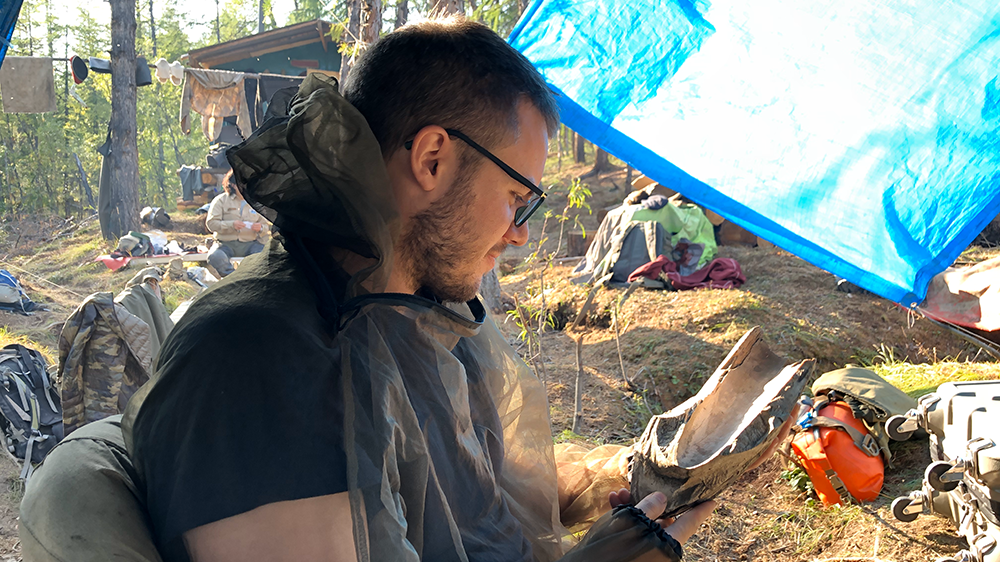
Mereghetti to study how megaherbivore diversity affects Arctic vegetation
Determining how the diversity of plant-eating megafauna has affected vegetation in the Arctic over the past 150,000 years will be the focus of a new University of Maine study funded by the National Science Foundation.
Alessandro Mereghetti, a UMaine Ph.D. student in ecology and environmental sciences, received a $56,118 Arctic Doctoral Dissertation Research Improvement Grant from NSF for his project. These grants are designed to support studies “that advance a fundamental, process and systems-level understanding of the Arctic’s rapidly changing natural environment and social and cultural systems, and, where appropriate, to improve our capacity to project future change,” according to NSF.
Megaherbivores such as caribou, bison and muskoxen promote nutrient cycling, plant growth and diversity in the Arctic by foraging and trampling across the region. As a result, these animals also reduce interspecies competition between plants, permafrost thaw and shrubification, all of which can help protect Arctic vegetation from the effects of climate change.
The Arctic was once home to a larger variety of megaherbivore species, including woolly mammoths, wild horses, woolly rhinoceroses and cold-adapted antelope, until the end of the last ice age, at which point the majority of them became extinct. Through his latest study, Mereghetti hopes to find out whether having a more diverse pool of megaherbivores thousands of years ago — as opposed to only a few species today — provided Arctic vegetation greater stability and resilience to climate change at the time.
Examining the extent of megaherbivore influence on Arctic plant life in the past could help scientists better understand present dynamics, particularly as some scientists suggest reintroducing certain megaherbivores to the region as a possible manage vegetation, permafrost thaw and carbon emissions, Mereghetti says.
“Learning how northern ecosystems worked in the past can give us clues on new management strategies to address the challenging future in front of us,” says Mereghetti, who collaborates with Jacquelyn Gill, associate professor of paleoecology and plant ecology with the UMaine School of Biology and Ecology and Climate Change Institute.
Mereghetti’s study will focus on Squirrel Lake, located in the far north region of Alaska within the Arctic Circle.

The area was part of what was once the most extensive biome on the planet: the mammoth steppe. It stretched across most of Europe, Siberia, Alaska and Canada’s Yukon, until it disappeared 10,000 years ago. Mergehetti says biological diversity of the mammoth steppe, which is also referred to as the “Serengeti of the ice age,” and its persistence through millendia of climatic and ecological transitions make it a “model system for understanding megaherbivore impacts on Arctic plant communities under climate change.”
In the summer, Mereghetti will excavate sediment cores from Squirrel Lake to analyze the ancient DNA, plant macrofossils, fungal spores and pollen within them. He also plans to create a database of existing georeferenced and radiocarbon-dated megaherbivore remains from Alaska to support his research.
With both the new core samples and the database, Mereghetti will create a high resolution chronology of Arctic plant and megafauna diversity over the past 50,000 years in Squirrel Lake. The chronology will inform Mereghetti of how megaherbivore variety changed over time, how that relates to plant composition and which species may have been important for maintaining past Arctic ecosystem properties.
It will be the “first long-term, high resolution record of species-level herbivore diversity, vegetation composition and climate from a record that spans two interglacial warm periods,” Mereghetti says.
“Having access to such a long, high-resolution record of biodiversity and environmental change in the Arctic will not only allow us to improve our knowledge of the past, but also to better understand our present and be more aware of what could happen in the future,” Mereghetti says.
The data gathered from the project will be used to create educational materials about ice age ecosystems and how they changed over time for rural middle schools in Alaska and Maine. These materials included a virtual reality game that’s already in development as part of another UMaine project, and 3D-printed dioramas displaying the evolution of plant and animal life in Squirrel Lake overtime. Mereghetti also plans to specifically share his research with various communities in the Kotzebue region of northern Alaska, where Squirrel Lake is located, and create exhibits and classroom kits for them.
In addition to investigating the relationship between megaherbivore diversity and arctic vegetation, Mereghetti has been analyzing fossilized feces from Siberia, Russia to find out which animals lived there more than 20,000 years ago, what plants they ate and how they interacted with the landscape over millennia.
Contact: Marcus Wolf, 207.581.3721; marcus.wolf@maine.edu
